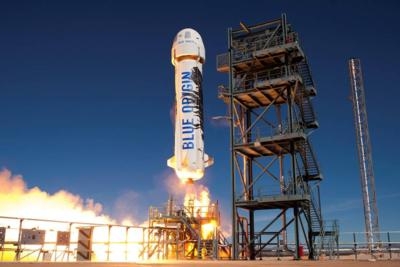New Shepard Escape System Proved Effective
Blue Origin—the space-launch subsidiary of Amazon boss Jeff Bezos’s business empire—is an impressive outfit with an excellent safety record.

The company’s crew-rated suborbital launch vehicle—dubbed New Shepard in homage to American astronaut, moonwalker, Naval Aviator, test-pilot, and bona fide NASA legend Alan Shepard Jr.—has borne satellites, space station supplies, and human beings spaceward over a protracted and unbroken series of safe, successful launches.
Alas, in keeping with the ethos popularized by England’s King Henry II—who famously maintained nothing in life has any business being perfect—a mission-ending anomaly occurred during an unmanned flight of Blue Origin’s New Shepard rocket on the morning of 12 September 2022. No lives were lost in the incident, and both Blue Origin and New Shepard—within the context of spaceflight malfunctions—acquitted themselves honorably.

The New Shepard spacecraft lifted off from Blue Origin’s West-Texas launch site at approximately 10:26 CDT carrying 36 payloads containing scientific research equipment. One minute and four seconds into the flight, as the vehicle passed through 9,000 meters, the New Shepard capsule's solid rocket motor-powered escape system fired, safely pulling the capsule away from the rocket.
Blue Origin later confirmed that New Shepard had suffered a booster failure and that the escape system had performed exactly as designed. Had a crew been aboard the capsule, they would have experienced a memorable tumult of racket and high gravitational forces before landing—inauspiciously but unhurt—in the West Texas desert.
Spaceflight aficionados will note with interest that the booster malfunction occurred after New Shepard had passed through max Q, the point along a rocket’s ascent trajectory at which the vehicle is subject to maximum dynamic stresses. Telemetry indicates New Shepard’s BE-3 rocket engine was throttling back up to continue the vessel’s climb to space when a large, atypical plume of flame erupted from the engine’s bell.
Notwithstanding sensationalist news reports aggrandizing the perils of spaceflight, the 12 September incident occasioned New Shepard’s first failed mission since the program’s 29 April 2015 inaugural launch—which saw a nominal flight and a safe landing of the vehicle’s capsule, but a loss of its booster section. In the years since New Shepard has made no fewer than twenty consecutive, successful spaceflights and landings—all of which resulted in Mr. Bezos’s capsules and boosters returning safely and soundly to Earth.

Among those twenty launches were six manned missions which saw characters the likes of Jeff Bezos, undersea explorer Victor Vescovo, FAA Inspector and NTSB Investigator Mary “Wally” Funk, and adventurer and Guinness world-record holder Hamish Harding make safe—and very expensive—round-trips to space.
Prior to the 12 September booster hiccup, Blue Origin had completed three successful crewed spaceflights in 2022. Whether or not the company carries more souls to space in this weird year-of-the-tiger remains to be seen. Certainly, New Shepard missions will be sidelined while engineers endeavor to determine the cause of the booster malfunction.
The capsule escape system, however, is a pip.
 Aero-TV: DeltaHawks Diesel Power Steps Into the Spotlight
Aero-TV: DeltaHawks Diesel Power Steps Into the Spotlight NTSB Prelim: Mooney Aircraft Corp. M20K
NTSB Prelim: Mooney Aircraft Corp. M20K ANN FAQ: Turn On Post Notifications
ANN FAQ: Turn On Post Notifications ANN's Daily Aero-Linx (12.20.25)
ANN's Daily Aero-Linx (12.20.25) Aero-News: Quote of the Day (12.20.25)
Aero-News: Quote of the Day (12.20.25)




